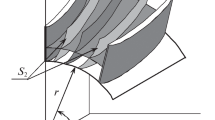The method of discrete characteristics, which can be used to solve problems of a flow past plane and three-dimensional bodies, is examined. The problem of a flow past thin supercavitating blades is solved by the method of discrete characteristics “3/4.” A block diagram of the algorithm for solution of this problem is presented. The model proposed permits more accurate calculation of the mechanism responsible for flow past effective members of supercavitating reactors.
Similar content being viewed by others
References
A. A. Samarskii and A. P. Mikhailov, “Mathematical modeling in the information age,” Vestn. Ross. Akad. Nauk, No. 9, 781 (2004).
V. M. Ivchenko, Hydrodynamics of Supercavitating Mechanisms [in Russian], Izd. Irkutsk. Univ., Irkutsk (1985).
V. M. Ivchenko, V. A. Kulagin, and A. F. Nemchin, Cavitation Technology [in Russian], Izd. Krasnoyar. Univ., Krasnoyarsk (1990).
V. G. Mishkevich, “Quadrature formulas for one-dimensional singular integrals,” Hydrodynamics of High Velocities: Interuniversity Collection [in Russian], Krasnoyar. Politekhn. Inst., Krasnoyarsk (1981), pp. 58–72.
E. E. Egorov and S. I. Polyakov, “Numerical solution of cavitation problems using a quadrature for a singular integral,” Hydrodynamics of High Velocities: Interuniversity Collection [in Russian], Krasnoyar. Politekhn. Inst., Krasnoyarsk (1985), pp. 150–162.
V. M. Ivchenko and D. E. Chupakha, “Bubbling flow past a cascade of supercavitating blades,” Hydrodynamics of High Velocities: Interuniversity Collection, [in Russian], Krasnoyar. Politekhn. Inst., Krasnoyarsk (1978), pp. 29–36.
V. A. Kulagin, A. P. Vilchenko, and T. A. Kulagina, Modeling of Dual-Phase Supercavitating Flows: Monograph [in Russian], IPTs KGTU, Krasnoyarsk (2001).
I. T. Egorov,Yu. M. Sadovnikov, I. I. Isaev, et al., Artificial Cavitation [in Russian], I. T. Egorov (ed.), Sudostroenie, Leningrad (1971).
V. M. Roman, “Analysis of a supercavitating wing based on surface-bearing theory,” Hydrodynamics of High Velocities: Interuniversity Collection [in Russian], Krasnoyar. Politekhn. Inst., Krasnoyarsk (1981), pp. 49–58.
Author information
Authors and Affiliations
Additional information
Translated from Khimicheskoe i Neftegazovoe Mashinostroenie, No. 10, pp. 10–13, October, 2009.
Rights and permissions
About this article
Cite this article
Likhachev, D.S., Kulagina, L.V. Method of solving problems of flow past a cascade of supercavitating blades in hydrodynamic reactors. Chem Petrol Eng 45, 603–608 (2009). https://doi.org/10.1007/s10556-010-9245-5
Published:
Issue Date:
DOI: https://doi.org/10.1007/s10556-010-9245-5




